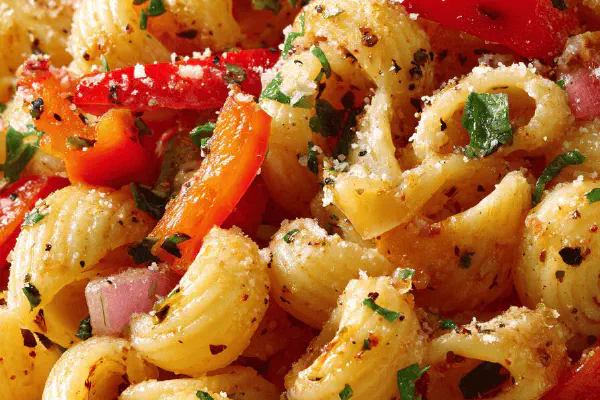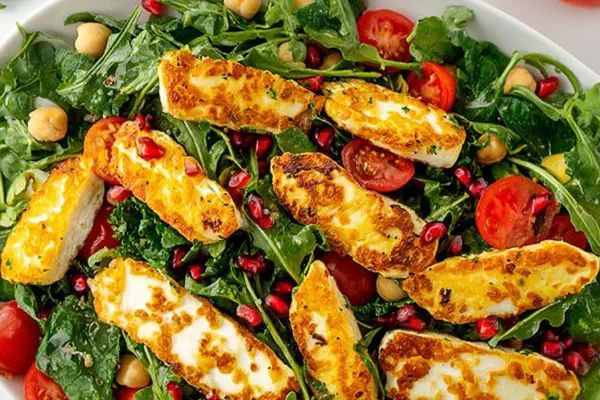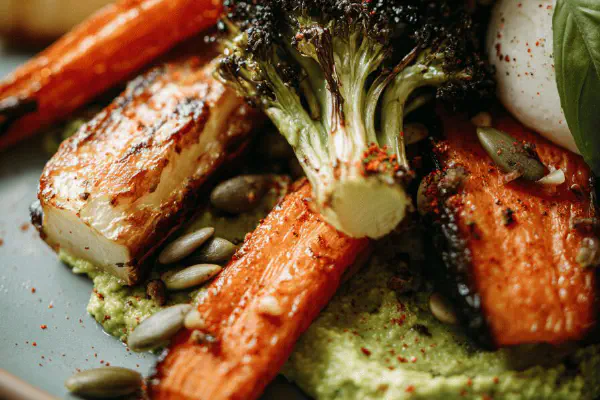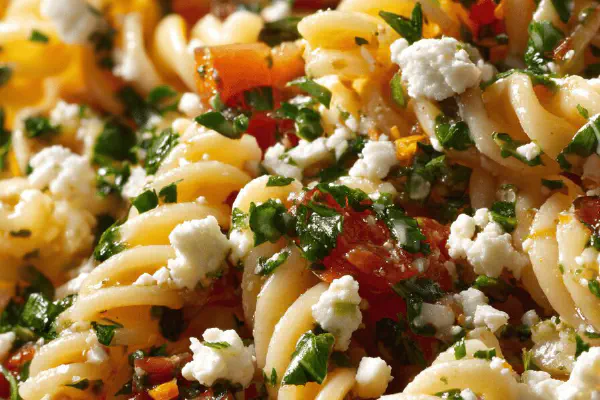Featured Recipe
Pasta Salad with Asparagus and Bocconcini

By Kate
"
A veggie-packed pasta salad with short pasta, tender asparagus, creamy bocconcini, and fresh tomatoes. A tangy balsamic dressing with olive oil, garlic, and a hint of chili. Cook pasta and asparagus together to save time. Chill quickly. Mix basil for aroma. Serve warm or cold. Nut-free, egg-free, vegetarian.
"
Prep:
25 min
Cook:
17 min
Total:
42 min
Serves:
5 servings
pasta
salad
vegetarian
Mediterranean
Introduction
Short pasta cooked al dente. Asparagus joins in last minutes. Quick dip under cold water to halt heat. Bocconcini, soft and creamy, sliced in halves or quarters. Cherry tomatoes add juicy bursts. Basil chopped fine, herbal and bright. Dressing tangy: red wine vinegar and olive oil whisked with fresh garlic and chili flakes. Salt and pepper fine-tune. Mixed vigorously so every bite’s coated but not soggy. Chill or serve room temperature. Minimal fuss but fresh bite. No nuts or eggs here. Simple Mediterranean vibes straight to bowl. Light, flexible side or main for warm days or lunches. Change red wine vinegar with champagne vinegar for sweet zip or add capers for salty punch.
Ingredients
Dressing
- 50 ml red wine vinegar
- 50 ml extra virgin olive oil
- 2 garlic cloves, minced
- 1 pinch crushed red pepper flakes
- Salt and pepper
About the ingredients
Short pastas like penne or fusilli hold dressing well. Increase asparagus for crunch or choose blanched broccoli florets instead for a twist. Bocconcini is soft and mild, try baby mozzarella pearls for a firmer bite. Cherry tomatoes can be red or yellow for color pop. Basil should be fresh, chopped just before tossing to keep herbal aroma intact. Use a good quality olive oil to enhance the flavor. Red wine vinegar is tangy but mellow; substitute with champagne vinegar for subtle sweetness. Garlic mincing is key to avoid big chunks but keep sharp notes. Chili flakes can be dialed back or omitted if heat isn’t wanted. Salt and pepper last because they bring other ingredients out.
Method
Dressing
- 1. Whisk vinegar, olive oil, garlic, red pepper flakes, salt, and pepper vigorously in a large bowl. Adjust seasoning as needed.
- 2. Bring salted water to boil. Add pasta, cook for 12 minutes. Add asparagus for last 3 minutes. Drain everything promptly.
- 3. Rinse pasta and asparagus under cold water to stop cooking. Toss lightly with a drizzle of olive oil. Let cool slightly.
- 4. Combine pasta, asparagus, bocconcini, tomatoes, and basil into the dressing. Toss until well coated.
- 5. Taste, tweak salt, pepper, or vinegar to balance flavors before serving.
Technique Tips
Timing for pasta and asparagus is key; asparagus softens fast but still needs bite so add it toward the end of pasta cooking. Rinsing quickly under cold water stops the cooking ensuring crisp texture and prevents clumping. Drizzling a little olive oil after rinsing stops sticking while cooling. Dressing should be whisked well so oil and vinegar emulsify slightly, flavor peaks when garlic and chili are freshly minced for pungency and warmth. Toss ingredients gently so bocconcini pieces hold shape but are coated thoroughly with dressing. Always taste before serving; balance acidity and seasoning based on the pasta and tomato sweetness. Leftovers keep well for a day, best served chilled. Add toasted pine nuts or olives for garnish when eating but not needed in base.
Chef's Notes
- 💡 Use fresh ingredients for best flavor. Quality olive oil is crucial. Fresh basil chopped just before mixing enhances aroma. Red wine vinegar adds noticeable acidity. Don't skip garlic mincing; it sharpens taste. Avoiding clumps is key, especially with dressing. Rinse pasta and asparagus immediately after cooking. It halts the heat. Toss all ingredients gently. Keep bocconcini intact while well coated.
- 💡 Adjust seasoning before serving. Taste is essential; tweak salt, pepper or vinegar. Pasta should not overpower other flavors. Insufficient dressing makes salad bland. Adding more tomatoes can brighten overall taste. If heat is unwanted, reduce chili flakes or omit. Consider substitutions like champagne vinegar for sweetness. Flexibility is important; you can adjust based on personal preference.
- 💡 Store leftovers properly to maintain texture. Place in airtight container. Best enjoyed cold after chilling. Can last a day in the fridge. Pasta tends to absorb dressing over time, so consider saving some dressing for fresh servings. Quick reheating in microwave can work too, but pasta salad shines when served chilled. Adding nuts or olives last minute gives variety.
- 💡 Experiment with different vegetables. Broccoli florets instead of asparagus offers a crunchy twist. Watch cooking time; don't overcook broccoli. A mix of cherry tomato colors adds visual appeal. Red, yellow; both work well. Use baby mozzarella if bocconcini is unavailable. Various cheeses can alter flavor and texture, make sure to adjust quantities for balance.
- 💡 Basil's flavor fades quickly. Best to chop right before use. Herbs can elevate taste, especially fresh ones. Consider adding capers for a salty punch. Adjust quantities thoughtfully; they can overwhelm. Small amounts can create contrast. Always whisk dressing well. Oil and vinegar must emulsify slightly; it enhances coating of ingredients. Avoid large chunks of garlic, keep it smooth.
Kitchen Wisdom
How to make salad ahead of time?
Prepare all components separately. Chop veggies day before. Cook pasta, asparagus. Chill everything. Toss right before serving.
Can I use other pasta types?
Absolutely. Choose any short pasta. Fusilli, penne work great too. Cooking times may vary. Just check doneness often.
What if I dislike tomatoes?
Substitute with diced cucumbers or bell peppers. They offer crunch and flavor. Add roasted veggies for warmth. Stay flexible with mix.
How to store leftovers?
Keep in airtight container in fridge. Enjoy cold, fresh flavors. Best eaten within a day. You can add dressing later for moisture.



